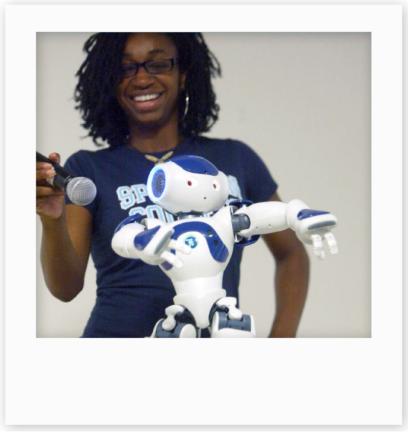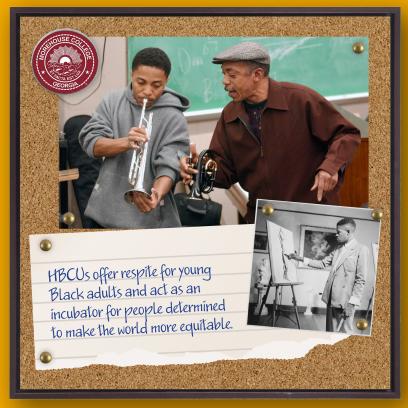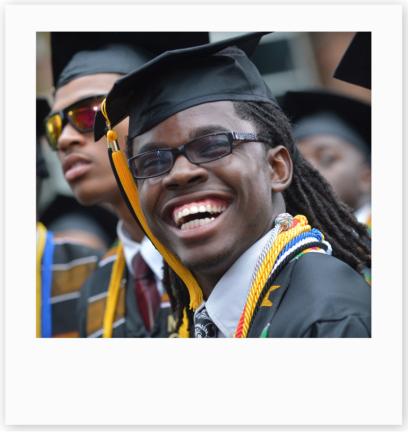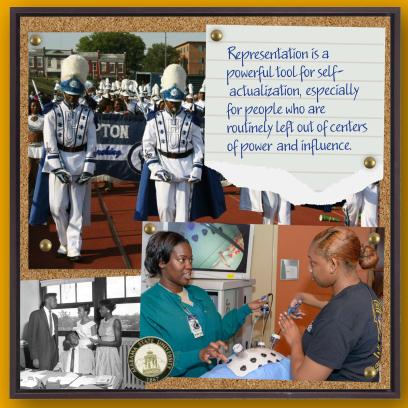There’s a point in your life as a parent, as a father, when you find yourself in uncharted territory. One point is when your child has an idea about their future that you never considered. That point for me was when my daughter told us that she wanted to be a doctor.
Of course, I was proud. Medicine is an incredible field filled with talented, giving people who spend their lives trying to help others. But I had nothing in my background to pull from. No life experience I could impart to help her along this journey. All I knew for sure is what my parents told me and what I’m sure every Black person has heard a million times in their lives: “If you are going to be successful, you will have to work twice as hard to be considered just as good.”
For those reading who are not Black, understand that little Black boys and girls are raised knowing that this country has a long history (distant and recent) of undermining and sometimes erasing Black achievement. They know that mediocre will not cut it, not for long. If you want to appear competent, you study for four hours where others study for two. If class starts at 9 a.m., be there at 8:55. It is tiresome, draining, and ultimately necessary to always strive for excellence just to be seen as competent.
I’ve done a lot of hard work in my life. As someone who grew up playing music in the school band, I’ve spent thousands of hours practicing on my saxophone—devoting nights and weekends to chasing excellence. And while I never pursued medicine, I know it’s very hard work. I know the hours are notoriously tough. The exams are brutal. I would be lying if my knees didn’t shake a little when I contemplated what it would take to succeed as a Black woman in a field that is already incredibly taxing. Not due to lack of faith in my daughter, but because I could not see far enough down that road to prepare her for what was coming. I could not look back in my own life to offer any clues because my life had been so different.
In 1991, I was a smart kid and pretty good musician about to graduate from high school in Southern Florida. Even though I had no political dog in the fight or any military background, I had all but decided my future was in the Army as part of the military band. Chance had it that my high school band director was a graduate of Xavier University of Louisiana, an HBCU (historically Black college or university) in New Orleans. He suggested I think about college, specifically a Black college, instead of the military. This one conversation changed the trajectory of my life.
Ultimately, I chose Bethune-Cookman University in Daytona Beach—mainly because it was the closest HBCU to my house—making me the first in my family to attend and graduate from college. So you can imagine that I was not particularly prepared for the experience, which was highlighted by a phone conversation I had with my mother shortly after meeting my band director, Dr. Harold Bray.
“Yeah, he’s a doctor, too. I guess he teaches and then works in a hospital to deliver babies,” I told my mom on the phone, astonished. I laugh now, but 18-year-old me had never met a Black PhD before. I had no frame of reference for what the fruits of academic labor looked like. I had never thought about education as a goal in and of itself—just a requirement. But at Bethune-Cookman, I began to understand and admire people my age who strove to be greater, who did not aspire to hang out on the corner for the rest of their days.
At Bethune-Cookman, the kids wanted to be better. They had ambition, and that ambition began to rub off on me. Soon, I was joining organizations I’d never thought to join, taking courses I’d never thought to take. I thought, “If these people can do it, so can I.”
What I didn’t quite appreciate at the time but am grateful for now is that Bethune-Cookman was giving me models of success I had never seen before. I was witnessing ambition in real time as my fellow students booked it to class and camped out in libraries. I was seeing the results of that ambition in my professors, who opened the world of science and history to me while treating me like their own child. This university gave me a new appreciation for Black people, my people, and everything we have contributed to the world, sometimes despite the world. Every day I swam in the waters of Black excellence, and it made my chest big with pride.
I couldn’t have known then, but that sense of belonging would be crucial for my success; indeed, the success of most students, especially in their first year, is dependent on that feeling of belonging. According to a summary of research by the Teaching + Learning Lab* at the Massachusetts Institute of Technology, “Numerous … studies spanning the K–20 spectrum have reported a connection between a student’s sense of belonging to a community or set of communities, and the student’s achievement motivation, expectations to achieve, as well as actual academic achievement.”1
When I was at Bethune-Cookman, I didn’t know all of this research on the importance of belonging. But I lived it. So when my daughter declared she wanted to be a doctor, I knew that one piece of the puzzle would be finding the right HBCU for her. And I knew there would be several to choose from. One of the reasons I was so confident in HBCUs was not just my personal experience but their track record for graduating roughly 50 percent of all Black doctors in this country.2
Consider Spelman College in Atlanta, which “has been recognized by the National Science Foundation as the leading producer of Black women who earn doctorates in the sciences—even while 45 percent of its students come from low-income families.”3 Spelman has graduated the likes of Audrey F. Manley, the first Black female chief resident at Cook County Children’s Hospital in Chicago and the first Black female assistant surgeon general.4 While the push for more people of color in STEM (science, technology, engineering, and mathematics) feels recent, Spelman was ahead of the curve: nearly 40 years ago, the school “committed itself to becoming the nation’s principal educator of Black women in STEM fields.”5
But Spelman isn’t the only HBCU excelling in STEM. Xavier University of Louisiana “produces more Black students who graduate from medical school each year than any other university in the United States.”6† These are the stories and headlines too often left out of the narrative about the state of Black education and replaced with narratives about failure and dysfunction.
My confidence in HBCUs is not simply personal. These schools—a network of more than 100 schools nationwide—have been serious about Black excellence since the 1800s. A recent study by the United Negro College Fund7 showed that while HBCUs make up roughly 3 percent of all colleges and universities, they educate 10 percent of all Black college students and nearly 20 percent of Black students in STEM majors. (And even though my focus here is STEM, I have to mention our judicial system: HBCUs account for 80 percent of Black judges and 50 percent of Black lawyers.)
When we coupled that with the fact that Black STEM students at HBCUs are less likely to experience identity threat than their peers at predominantly white institutions (PWIs),8 the choice seemed even clearer.
Ultimately, my daughter chose Howard University—not far from where her old man works—and earned a degree in chemical engineering. As an undergrad, she had access to Howard University Hospital, where she developed and applied practical knowledge, and to professors who looked like her and who went from the operating room to the classroom. Now, she’s in medical school at Emory University. But that win is bittersweet, because I know for every one child with her story, there are 10 more without it.
Equalizing STEM Opportunities
When my daughter told me she wanted to be a doctor, I was a long way from the college freshman who didn’t know the difference between an MD and a PhD. I knew it would take years of planning, researching, and money to properly nourish her dream. And because I was lucky enough to have Black teachers and professors who saw promise in me (and because I had made good on that promise through hard work), I had the financial resources to supplement my daughter’s STEM education. For example, she attended STEM programs at the University of Michigan and Boston College while moving through high school. And unlike many Black students, she was able to take many challenging STEM courses at her public school.
Obviously, all public school students are introduced—to varying degrees—to subjects like math, biology, chemistry, and other sciences as they progress from elementary to high school. But that picture becomes less equitable as coursework becomes more specified and intense. One critical disparity is in access to calculus. A shocking 20 percent of Black students (compared with 13 percent of white and Hispanic students) are in high schools that don’t offer calculus, according to researchers with the Urban Institute. They framed that inequity as a civil rights issue because Black students are among those who benefit the most from advanced math courses—such courses increase both learning and the likelihood of choosing and completing a STEM degree.9
Similarly, advanced coursework in all subjects has been found to enhance students’ self-esteem and increase engagement, resulting in fewer absences and suspensions.10 But the on-ramps to advanced coursework in high school can appear as early as elementary school with “gifted and talented” programs, or in middle school with Algebra I and other advanced coursework; for students who are not identified as “gifted” early on, it can be much more difficult to gain access to these kinds of preparation, requiring persistent advocacy and significant time and energy that families may not have.11 An analysis by the Center for American Progress found a concerning “funnel” reducing Black and Indigenous students’ opportunities to experience Advanced Placement (AP) and other advanced courses. While Black students were only slightly less likely than white students to attend a school that offers AP courses, Black students were far less likely to enroll in those courses. And, of those who enrolled and took an AP test, Black students were far less likely to earn passing scores.12
There are plenty of reasons for this, but there are two I feel the need to highlight: the legacy of redlining and the lack of diversity among teachers.
Redlining
The biggest culprit began nearly 100 years ago, when the federal government took steps to protect homeownership during the Great Depression—but only for white homeowners. The government-sponsored Home Owners’ Loan Corporation (HOLC) bought up mortgages that were about to default and offered new loans with more favorable terms. In determining which loans to refinance, the HOLC implemented the practice of redlining, a (fully legal) housing segregation policy that identified which neighborhoods were safe or unsafe for investment, using explicitly racial criteria; regardless of socioeconomic status, neighborhoods with Black residents were designated red, or highest risk, while neighborhoods with white residents were much more likely to be designated green, or safe for investment. The Federal Housing Authority (FHA), which was created to help renters become homeowners, also refused to insure mortgages in or near Black neighborhoods—with the explicit goal of maintaining segregated schools as well as neighborhoods. To make matters worse, the FHA—an arm of the federal government—funded and worked with builders who refused to sell homes to Black people. Under these policies, Black neighborhoods or even the appearance of Black neighbors became a sign of trouble, places and people to be avoided by white people for fear of losing their investments or bringing harm to their children.13
These practices didn’t just explicitly maintain a system of racial segregation—they also exacerbated the wealth gap. Black people were essentially trapped in neighborhoods and homes that could not accrue the same levels of value to be passed down to their kids, systematically endowing this cornerstone of wealth-building to white people.
However, another cost was the quality of education these Black families were—and still are—able to obtain. In addition to maintaining school segregation (explicit or de facto), redlining impacted and continues to impact the health of local schools,14 which are primarily funded on the local level by property taxes. The lower the value of homes, the less money flows into schools. That means lower-paid teachers and fewer resources for those who need it most. Some of those resources, like AP courses, end up being the purview of wealthier, whiter neighborhoods that are often out of reach for Black families.
In many ways, HBCUs have been our conduit to the middle class when other ways were closed to us. While white men returning after World War II took advantage of the GI Bill, which helped them buy houses and build the generational wealth that is still being enjoyed today, Black soldiers were barred from that government handout. This is one reason you so often see the Black community relying on itself to save itself, to feed and clothe itself. Our HBCUs, though built primarily to educate when others refused, have had another purpose: building the Black middle class and building equity at the same time. HBCUs not only give us access to high-quality education—they also correct the wrongs of redlining by helping students from families with low incomes seek the American dream.
By providing “nearly twice as much college access to low-income students than other colleges and universities,”15 HBCUs have become a crucial lifeline for Black folks. At non-HBCUs, only about 32 percent of students receive Pell grants (which are only for students with low incomes), but the percentage is more than double that at HBCUs.
The cumulative impact is enormous. Evidence suggests that HBCUs are far more effective than highly ranked universities in moving students up the economic ladder.16 That is a real, tangible impact on the wealth, and therefore the health and well-being, of the Black community. This is the reason Black folks treat high school graduations like parties—we know our babies are on a path to do better for themselves and, ultimately, for the community they came from.
As impressive as this is, HBCUs should not be shouldering so much of the weight of recovering from redlining. There is a consistent correspondence between redlined neighborhoods, concentrated poverty, and school funding inequity. Our K–12 funding system depends heavily on local property taxes, and Black homeowners tend to have lower incomes and home values than white homeowners. That means less local money available for Black students, even as greater investments are needed to help them reach the same educational outcomes.17
While redlining is no longer legal, it’s still setting up Black families and students to fail. Districts serving majority Black students are far more likely to have inadequate funding and to have poor student outcomes—in a recent study from the Albert Shanker Institute, 76 percent of the nation’s majority Black/Hispanic districts were underfunded and scored below the US average on math and reading tests, compared to only 14 percent of majority white districts. Racial segregation in the United States was intentional, coordinated, and large-scale, and we need similarly intentional, coordinated, and large-scale interventions in both housing and K–12 school funding systems in order to right these wrongs.18
This vicious cycle is often ignored while society instead congratulates those few who escape it as examples of hard work and determination. I’m not here to say otherwise, only to point out that sometimes you also need just plain luck to help you escape the systems that trap you. My story is a testament to that.
Teacher Diversity
One way I got lucky was having about 90 percent Black teachers in K–12. Sadly, that was just luck because the teaching force has long been primarily white. These days, the numbers are a little better, but they are still not where they need to be: the teaching profession is 79 percent white, with Black teachers making up only 7 percent of the force. In contrast, just 47 percent of K–12 students are white, and 15 percent are Black.19
Recruiting and retaining more Black teachers is critical because research repeatedly shows that Black students benefit greatly when they see and are seen by Black teachers. One study says that Black students who have at least one Black teacher by the third grade are 13 percent more likely to go to college. That number jumps to 32 percent if they have two Black teachers. And for Black boys like me, from low-income families, on-time high school graduation rates jump nearly 40 percent with just two Black teachers in their lives.20
The simple truth is that representation is a powerful tool for self-actualization, especially for people who are routinely left out of centers of power and influence. Networks like BET, magazines like Ebony, or movies like Black Panther are not just there to serve a niche commercial demographic; they are there to feed the souls of those who don’t see themselves reflected, let alone lauded, in a proportionate way. It may be hard to truly grasp if you’re from a group that is often the default, but seeing a Black woman on the Supreme Court makes the dreams of little girls real. Seeing a Black family in the White House makes the United States feel more like home.
But these avatars for hope start much closer to home by way of teachers, the mentors our children look to in order to learn about the larger world outside their windows and their place in it. And when Black children don’t see Black educators holding classes on the intricacies of gravity or how photosynthesis works, it signals a long, lonely road toiling as an “only” in their future STEM classes and professions.
Thankfully, we know Black teachers have an impact on taking advanced courses, such as AP, honors courses, and International Baccalaureate. Not only are Black students more likely to enroll, students of all races and ethnicities are too.21 As a student who benefited from seeing and being seen by Black teachers, I can’t emphasize this research enough. As a father, I know seeing and being seen had a huge impact on my daughter too. And as a union leader, I’m committed to increasing teacher diversity—especially in STEM courses.
In July 2022, our Teacher and School Staff Shortage Task Force released its report Here Today, Gone Tomorrow?; it found, among other things, that retaining and expanding the number of Black teachers will require treating them like professionals, showing them the respect they deserve, and, yes, offering better compensation.‡
When you consider that HBCUs deliver half of all Black teachers,22 it only makes sense to empower and engage HBCUs when looking for the next generation of educators. Sadly, not enough attention or funding has been paid to these crucial institutions.
The United Negro College Fund released a study showing that the federal funding gap between HBCUs and PWIs quadrupled between 2003 and 2015, from $400 to $1,600 per student.23 And that gap is targeted: during that window, federal funding for HBCUs decreased much more dramatically than for PWIs, with the most significant declines for private HBCUs (about half of all HBCUs).24 But the problem is much worse than that. About 20 percent of HBCUs are land-grant schools, which are supposed to get annual funding from federal and state governments—but many states have refused to fund their share, to the tune of $12.8 billion between 1987 and 2020.25 And many non-land-grant public HBCUs have had to sue the states to get the funding they have been owed for decades.26
Among other problems with facilities, faculty pay, and more, this chronic underfunding puts HBCU STEM programs at a serious disadvantage. For students pursuing PhDs in STEM, the ultimate goal is to end up at an R1 (top-tier research) university. Researchers at R1 schools are significantly more likely to be awarded the grant funding they need to complete their research and advance in their careers—including in ways that reflect well on the university and make it more likely to attract funding, faculty, and the most promising students in the next generation of researchers. While many HBCUs have sought R1 status, none have received it to date.27 The impacts of generations of underfunding ripple out in a thousand ways like this, creating still more challenges that HBCU STEM programs, faculty, and students have to overcome.
While we know Black folks have always had to make dimes out of nickels, there’s no excuse for this targeted inequity. By deeming HBCUs unimportant to our nation’s overall education, this country has starved crucial institutions of crucial funding. This is not accidental. Everyone knows that the path to economic equity often goes through a school building, and if the past is prologue, then it’s not surprising that Black economic freedom—a major target of racist laws and intentions—is hobbled through the starving of Black centers of education.
But all the news isn’t bad.
Educators and students were elated to see the Biden-Harris administration recognize the vital role of HBCUs with several billion dollars in federal funding starting in 2021, including $3.7 billion in COVID-19 relief funding and $500 million in grant funding.28 In addition, the FY21 Omnibus Appropriations Act authorized the Department of Education to cancel nearly $1.6 billion in HBCU loans issued for capital improvements, the result of a bill sponsored by North Carolina Rep. Alma Adams.29 These are welcome signs from a government that seems to understand the value of Black education. But elections change things. Who is to say what will happen to HBCU funding if a politician who works overtime to erase our history from libraries and lauds the criminals who take our lives as “heroes” gets into the White House?
I am not here to say that every Black child must attend a Bethune-Cookman, a Hampton, or a Howard—or that no Black student should attend a predominantly white institution. But I do feel that a foundational pride and encouragement to excellence is a unique gift given only in the halls and campuses of HBCUs. So I’m glad to see interest in HBCUs surging. The New York Times reported in summer 2022 that applications to HBCUs rose 30 percent between 2018 and 2021.30
It is my opinion that young Black people watched the spread of President Trump’s naked bigotry, plus the constant deluge of Black people turned into hashtags thanks to often unpunished police officers, and looked to HBCUs as a welcome respite. I remember reading of four young women, all excellent students with acceptance letters to our country’s most prestigious Ivy League schools, saying they chose schools like Hampton and Spelman because “College is the time when you’re trying to figure out who you are…. It’s impossible to figure that out in a space where you not only feel like you have to assimilate to fit into that space, when they didn’t invite you there or they tolerate you there, but you have to prove that your existence has value.”31 HBCUs not only offer a respite for young adults but act as an incubator for people determined to make the world more equitable.
That feeling of belonging is crucial. If we want to maintain or increase the number of Black doctors, nurses, engineers, and scientists graduating from HBCUs, we have to nurture that same feeling of belonging in their K–12 education when it comes to STEM courses.
Education has proven to be one of the most reliable tools in Black America’s quest for equality in this country. As a leader, a teacher, and a father, I’ll close by speaking directly to Black youth: I ask you to consider joining the legacy of those like Vice President Harris, Supreme Court Justice Thurgood Marshall, public intellectual W. E. B. Du Bois, author Toni Morrison, and countless others. I ask you to join the ever-expanding ranks of Black excellence who have left an indelible mark on American history.
Fedrick C. Ingram is the secretary-treasurer of the AFT. Previously, he served as the president of the 140,000-member Florida Education Association and as an AFT vice president. In 2022, he was elected to serve as a trustee on the board of the NAACP Foundation. Early in his career, he was a music teacher and band director in Miami-Dade public schools; he has performed nationally as a saxophone soloist and conductor.
*For tips on how to enhance students’ sense of belonging, visit go.aft.org/v75. (return to article)
†For an in-depth look at how Xavier supports aspiring doctors, see go.aft.org/tgb. (return to article)
‡To read the task force’s report, visit go.aft.org/rfq. (return to article)
Endnotes
1. Teaching + Learning Lab, "Academic Belonging," Massachusetts Institute of Technology, tll.mit.edu/teaching-resources/inclusive-classroom/academic-belonging.
2. M. Hammond, L. Owens, and B. Gulko, HBCUs Transforming Generations: Social Mobility Outcomes for HBCU Alumni (Washington, DC: United Negro College Fund, 2021).
3. D. Smith, "The Facts on HBCUs: Top 10 Facts About Historically Black Colleges and Universities," The Century Foundation, September 19, 2022, tcf.org/content/commentary/the-facts-on-hbcus-top-10-facts-about-historically-black-colleges-and-universities.
4. Changing the Face of Medicine, "Dr. Audrey Forbes Manley," National Library of Medicine, National Institutes of Health, US Department of Health and Human Services, cfmedicine.nlm.nih.gov/physicians/biography_211.html.
5. Spelman College, "Simons Foundation Commits Nearly $5.7 Million to Support Science and Mathematics Faculty and STEM Studies at Spelman College," press release, September 28, 2022, spelman.edu/about-us/news-and-events/news-releases/2022/09/28/simons-foundation-commits-nearly-$5.7-million-to-support-science-and-mathematics-faculty-and-stem-studies-at-spelman-college.
6. Smith, "The Facts on HBCUs."
7. Hammond, Owens, and Gulko, HBCUs Transforming Generations.
8. E. Deemer et al., "Does University Context Play a Role in Mitigating Threatening Race-STEM Stereotypes? Test of the Stereotype Inoculation Model," Journal of Diversity in Higher Education (2022), psycnet.apa.org/record/2022-44231-001.
9. V. Lee and C. Lindsay, "Unequal Access to Calculus Could Hinder Low-Income and Black Students," Urban Institute, March 6, 2018, urban.org/urban-wire/unequal-access-calculus-could-hinder-low-income-and-black-students.
10. R. Chatterji, N. Campbell, and A. Quirk, Closing Advanced Coursework Equity Gaps for All Students (Washington, DC: Center for American Progress, June 2021), files.eric.ed.gov/fulltext/ED617048.pdf.
11. K. Patrick, A. Socol, and I. Morgan, Inequities in Advanced Coursework: What's Driving Them and What Leaders Can Do (Washington, DC: Education Trust, January 2020), files.eric.ed.gov/fulltext/ED603195.pdf.
12. Chatterji, Campbell, and Quirk, Closing Advanced Coursework.
13. R. Rothstein, "Suppressed History: The Intentional Segregation of America's Cities," American Educator 45, no. 1 (Spring 2021), aft.org/ae/spring2021/rothstein.
14. B. Baker, M. Di Carlo, and P. Green III, Segregation and School Funding: How Housing Discrimination Reproduces Unequal Opportunity (Washington, DC: Albert Shaker Institute, April 2022), shankerinstitute.org/sites/default/files/2022-05/SEGreportfinal.pdf.
15. Smith, "The Facts on HBCUs."
16. Hammond, Owens, and Gulko, HBCUs Transforming Generations.
17. Baker, Di Carlo, and Green III, Segregation and School Funding.
18. Baker, Di Carlo, and Green III, Segregation and School Funding.
19. K. Schaeffer, "America's Public School Teachers Are Far Less Racially and Ethnically Diverse Than Their Students," Pew Research Center, December 10, 2021, pewresearch.org/fact-tank/2021/12/10/americas-public-school-teachers-are-far-less-racially-and-ethnically-diverse-than-their-students.
20. S. El-Mekki, "To Achieve Educational Justice, We Need More Black Teachers," EdSurge, September 9, 2021, edsurge.com/news/2021-09-09-to-achieve-educational-justice-we-need-more-black-teachers.
21. C. Samuels, "Want to Draw More Students to Advanced Courses? Staff Them with Black Teachers," Education Week, February 26, 2020, edweek.org/leadership/want-to-draw-more-students-to-advanced-courses-staff-tehm-with-black-teachers/2020/02.
22. A. Ma, "HBCUs Produce Nearly Half of All Black Teachers in the U.S.," PBS Newshour, February 24, 2023, pbs.org/newshour/education/hbcus-produce-nearly-half-of-all-black-teachers-in-the-u-s.
23. T. Allen and G. Glover, "101 HBCUs Get Nearly 7 Times Les Money Than 1 Other School. That Must Change," Washington Post, June 17, 2022, washingtonpost.com/opinions/2022/06/17/increase-hbcu-funding.
24. Smith, "The Facts on HBCUs."
25. S. Adams and H. Tucker, "How America Cheated Its Black Colleges," Forbes, February 1, 2022, forbes.com/sites/susanadams/2022/02/01/for-hbcus-cheated-out-of-billions-bomb-threats-are-latest-indignity/?sh=6f3bc46f640c.
26. Smith, "The Facts on HBCUs."
27. Georgetown University, "HBCUs Seek Highest Recognition for Research and Innovation," The Feed (blog), November 11, 2022, feed.georgetown.edu/access-affordability/hbcus-seek-highest-recognition-for-research-and-innovation.
28. White House, "Fact Sheet: The Biden-Harris Administration's Historic Investments and Support for Historically Black Colleges and Universities," December 17, 2021.
29. J. Bey, "Biden-Harris Administration Sets the Record Straight on Its $5.8 Billion Promise to HBCUs," BET, January 26, 2022, bet.com/article/x7tz0e/biden-harris-administration-promise-to-support-hbcus.
30. E. Green, "Why Students Are Choosing H.B.C.U.s: '4 Years Being Seen as Family,'" New York Times, June 17, 2022, nytimes.com/2022/06/11/us/hbcu-enrollment-black-students.html.
31. Green, "Why Students Are Choosing."
[Photos: courtesy of Fedrick C. Ingram; Heritage Image Partnership Ltd / Alamy Stock Photo; Erik S. Lesser / Stringer / Getty Images Entertainment; Alpha Stock / Alamy Stock Photo; WENN Rights Ltd / Alamy Stock Photo; Kevin Coles / Flickr; AB Forces News Collection / Alamy Stock Photo; State Archives of Florida / Florida Memory / Alamy Stock Photo; Mandel Ngan / Staff / AFP / Getty Images]





